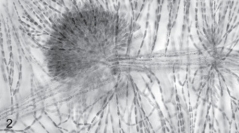

 Cryptogamie, Algologie
31 (4) - Pages 377-386
Cryptogamie, Algologie
31 (4) - Pages 377-386The first COI sequences from European material of Batrachospermum helminthosum and B. gelatinosum are presented and compared with equivalent data from North America. The variation between the continents was 53 bp (8) and 10 bp (1.5), respectively for the two species, suggesting cryptic diversity in at least the former species. Polysiphonia hemisphaerica from Norway and P. boldii from Texas differed by 8 bp (1.2). A hybrid tetrasporophyte produced from a cross between these two species revealed COI sequence identical with that of the female parent, demonstrating uniparental inheritance of mitochondria. Ptilota serrata and P. gunneri, which can be difficult to distinguish morphologically, were 38 bp (5.7) different with no intraspecific variation. Sequences for a species temporarily labeled as P. serrata sp.1 from eastern Canada in The Barcode of Life Data Systems (BOLD), were identical with that for P. gunneri from Norway. The morphologically similar species Plumaria plumosa is represented by triploid parasporangial plants and sexually reproducing plants that are geographically separated, with only the asexual phase at the northern part of the range. The two phases had COI sequences that differed by 4 bp. Sequences of the invasive species Gracilaria vermiculophylla from France and the Russian Far East (Vladivostok) were identical and similar to the reported invasive haplotype from elsewhere. In addition, COI sequences obtained for "Heterosiphonia" japonica and Antithamnion hubbsii from introduced populations in Norway are presented.
Also available on Connect.barcodeoflife